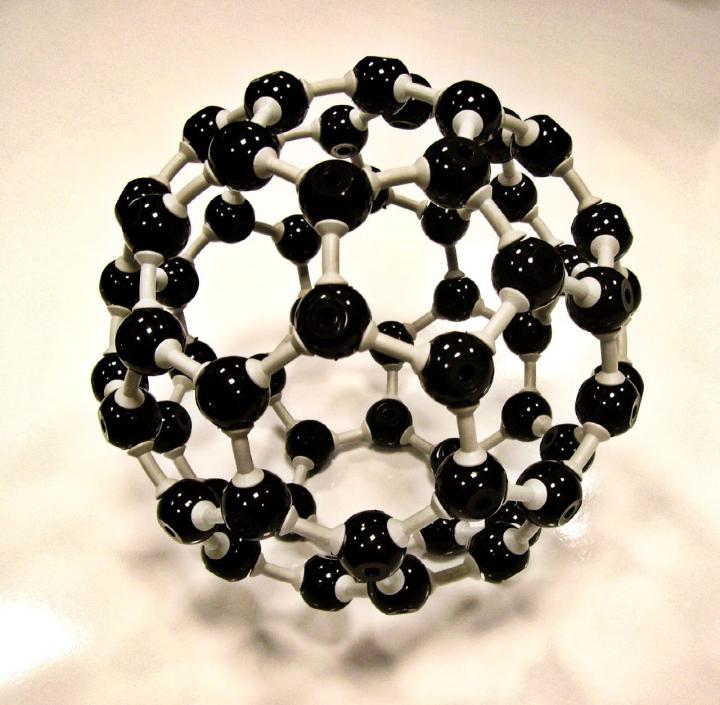Researchers create artificial protein to control assembly of buckyballs

Gevorg Grigoryan, an assistant professor of computer science at Dartmouth College, and his collaborators have created an artificial protein that self-organizes into a new material -- an atomically periodic lattice of buckminster fullerene molecules, or buckyball, a sphere-like molecule composed of 60 carbon atoms shaped like a soccer ball. Credit: St Stev via Foter.com / CC BY-NC-ND
“This is a proof-of-principle study demonstrating that proteins can be used as effective vehicles for organizing nano-materials by design,” says senior author Gevorg Grigoryan, an assistant professor of computer science at Dartmouth.
“If we learn to do this more generally – the programmable self-assembly of precisely organized molecular building blocks — this will lead to a range of new materials towards a host of applications, from medicine to energy.”
The study appears in the journal in Nature Communications. A PDF is available on request.
According to the U.S. National Nanotechnology Initiative, scientists and engineers are finding a wide variety of ways to deliberately make materials at the nanoscale – or the atomic and molecular level — to take advantage of their enhanced properties such as higher strength, lighter weight, increased control of light spectrum and greater chemical reactivity than their larger-scale counterparts.
Proteins are “smart” molecules, encoded by our genes, which organize and orchestrate essentially all molecular processes in our cells. The goal of the new study was to create an artificial protein that would self-organize into a new material — an atomically periodic lattice of buckminster fullerene molecules.
Buckminster fullerene (buckyball for short) is a sphere-like molecule composed of 60 carbon atoms shaped like a soccer ball. Buckyballs have an array of unusual properties, which have excited scientists for several decades because of their potential applications.
Buckyballs are currently used in nanotechology due to their high heat resistance and electrical superconductivity, but the molecule is difficult to organize in desired ways, which hampers its use in the development of novel materials.
In their new research, Grigoryan and his colleagues show that their artificial protein does interact with buckyball and indeed does organize it into a lattice. Further, they determined the 3-dimensional structure of this lattice, which represents the first ever atomistic view of a protein/buckyball complex.
“Learning to engineer self-assembly would enable the precise organization of molecules by design to create matter with tailored properties,” Grigoryan says.
“In this research, we demonstrate that proteins can direct the self-assembly of buckminsterfullerene into ordered superstructures. Further, excitingly, we have observed this protein/buckyball lattice conducts electricity, something that the protein-alone lattice does not do. Thus, we are beginning to see emergent material behaviors that can arise from combing the fascinating properties of buckyball and the abilities of proteins to organize matter at the atomic scale. Taken together, our findings suggest a new means of organizing fullerene molecules into a rich variety of lattices to generate new properties by design.”
###
The study included researchers from Dartmouth College, Sungkyunkwan University, the New Jersey Institute of Technology, the National Institute of Science Education and Research, the University of California-San Francisco, the University of Pennsylvania and the Institute for Basic Science.
Dartmouth Assistant Professor Gevorg Grigoryan is available to comment at gevorg.grigoryan@dartmouth.edu.
Broadcast studios: Dartmouth has TV and radio studios available for interviews. For more information, visit: http://communications.
Media Contact
All latest news from the category: Life Sciences and Chemistry
Articles and reports from the Life Sciences and chemistry area deal with applied and basic research into modern biology, chemistry and human medicine.
Valuable information can be found on a range of life sciences fields including bacteriology, biochemistry, bionics, bioinformatics, biophysics, biotechnology, genetics, geobotany, human biology, marine biology, microbiology, molecular biology, cellular biology, zoology, bioinorganic chemistry, microchemistry and environmental chemistry.
Newest articles

NASA: Mystery of life’s handedness deepens
The mystery of why life uses molecules with specific orientations has deepened with a NASA-funded discovery that RNA — a key molecule thought to have potentially held the instructions for…

What are the effects of historic lithium mining on water quality?
Study reveals low levels of common contaminants but high levels of other elements in waters associated with an abandoned lithium mine. Lithium ore and mining waste from a historic lithium…

Quantum-inspired design boosts efficiency of heat-to-electricity conversion
Rice engineers take unconventional route to improving thermophotovoltaic systems. Researchers at Rice University have found a new way to improve a key element of thermophotovoltaic (TPV) systems, which convert heat…



